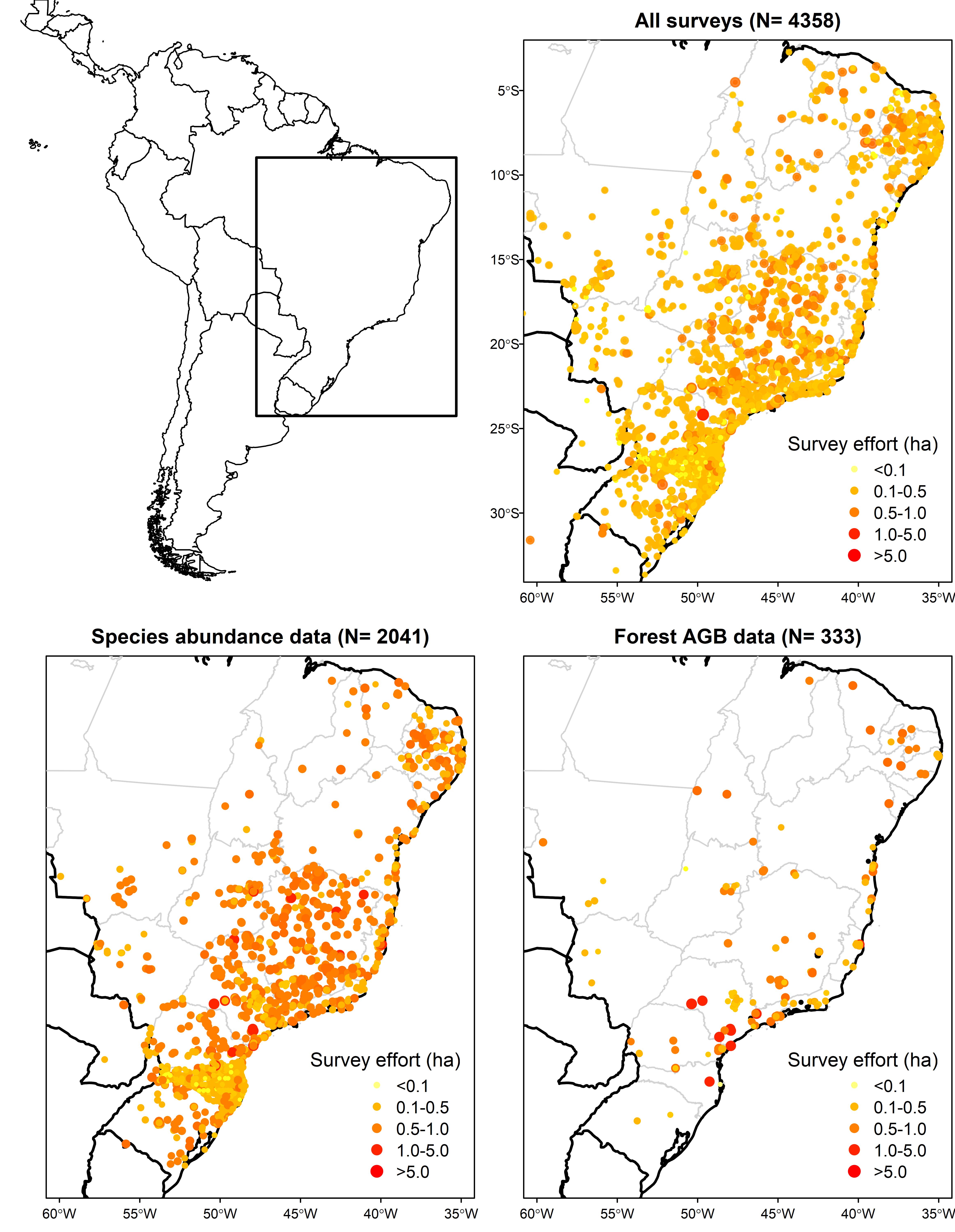Conteúdo
Destaques
Didáticos
Visitantes
Essa é uma revisão anterior do documento!
 A project that aims to compile and synthesize the existing knowledge on the structure and diversity of neotropical tree communities and the functional traits of their species. Currently, the project mainly contains information from the forests and shrublands of eastern South America, including the Atlantic Forest, Cerrado, Caatinga and Pantanal domains (i.e. extra-Amazonian neotropical domains). It includes surveys of all vegetation types, successional stages and sampling methods. The database is currently in version 4.0.
Read More
A project that aims to compile and synthesize the existing knowledge on the structure and diversity of neotropical tree communities and the functional traits of their species. Currently, the project mainly contains information from the forests and shrublands of eastern South America, including the Atlantic Forest, Cerrado, Caatinga and Pantanal domains (i.e. extra-Amazonian neotropical domains). It includes surveys of all vegetation types, successional stages and sampling methods. The database is currently in version 4.0.
Read More
IMPORTANT NOTE: This project currently has no funding and it is kept on the free time of its coordinators. Thus, replies to data requests may be delayed and priority is given to projects that can improve the quality of the database.
So far, TreeCo is composed by two main bodies of information:
 Figure 1. The current geographical extent covered by TreeCo (top left), the distribution of all the quantitative vegetation inventories stored in the database (top right), the inventories with species abundance data already entered in the database (bottom left), and the inventories with information on Tree Above-ground Biomass (AGB), excluding data from state forest inventories (bottom right). Thick lines present the official limits of Latin America, while the grey lines define the Brazilian states. The number of inventories with geographical coordinates (N) is given for each panel.
Figure 1. The current geographical extent covered by TreeCo (top left), the distribution of all the quantitative vegetation inventories stored in the database (top right), the inventories with species abundance data already entered in the database (bottom left), and the inventories with information on Tree Above-ground Biomass (AGB), excluding data from state forest inventories (bottom right). Thick lines present the official limits of Latin America, while the grey lines define the Brazilian states. The number of inventories with geographical coordinates (N) is given for each panel.
TreeCo is available upon reasonable request from researches interested in using the database for scientific purposes. We share all the data available as long as there is no overlap with ongoing projects, and if references and funding sources are properly cited. We are also more prone to share TreeCo data with researchers willing to give their input on the quantity/quality of the database than only using it. Young researchers willing to use the database in their grad or post-doc projects are especially welcome.
TreeCo coordinators are also open for collaboration on the research topics listed below ('Future research topics'). We are glad to provide lists of references and to share pdf copies of any study we may have. The use of other information stored in the database, such as the species composition, abundance and trait information, is also possible. But in this case, it may imply the participation of the project coordinators in the investigation and related publications.
The main scientific questions we want to answer using TreeCo are related to the following topics:
We are grateful for the hundreds of researchers, students and technicians that performed fieldwork, species identification and data analysis that resulted in the published and unpublished inventories that are included in TreeCo.
We also thank all people that have directly contributed to surveys and species data compilation, namely Gregory Pitta, Danilo Mori, Luiz Magnago, Markus Gastauer, Carolina Bello, Renato Toledo, Natália Targhetta and Geison Castro.
We are also greatly in debt with the researchers that provided their (un)published tree data: André Amorim, Andréia A. Rezende, Bruno R. Ribeiro, João A. Meira-Neto, João L.F. Batista, Marcelo Pansonato, Márcia C.M. Marques, Maria T.Z. Toniato, Mariana C. Pardgurschi, Mario J. Marques-Azevedo, Markus Gastauer, Ricardo R. Rodrigues, Robson L. Capretz and Victor P. Zwiener.
TreeCo database was funded by the São Paulo Research Foundation (FAPESP) grant 2013/08722-5 and by the European Union’s Horizon 2020 research and innovation program under the Marie Sklodowska-Curie grant agreement no. 795114.
The forest inventories compiled by TreeCo were funded by many different agencies, such as the Coordination for the Improvement of Higher Education Personnel (CAPES), by the National Council for Scientific and Technological Development (CNPQ) and by the many state-specific research funding agencies, such as FAPESP, FAPEMIG, FAPESC, FAPERJ, etc. These agencies funded the scholarships, fieldwork and/or equipment used to conduct these inventories.
We acknowledge some specific funding that resulted in the (un)published data included in TreeCo: São Paulo Research Foundation (FAPESP), grants 1999/08515-0, 1999/09635-0 and 2004/04820-3. Santa Catarina Research Foundation (FAPESC), grant 2017TR1922. Conselho Nacional de Desenvolvimento Científico e Tecnológico (CNPq), grant 312075/2013-8 and 484747/2011-8. US Department of Energy grant DE-FC26-01NT411151 (US Department of Energy).
If you think there is a major funding that should be added to this list, please e-mail the funding agency and grant number to raflima@usp.br.